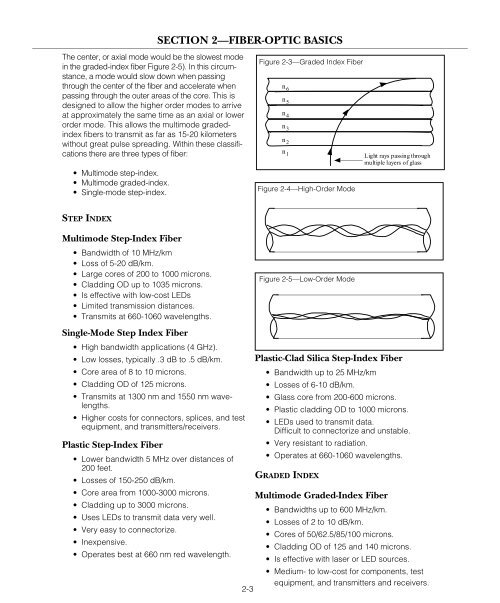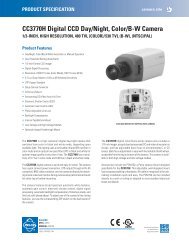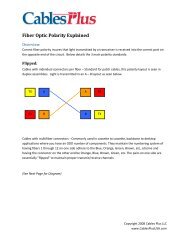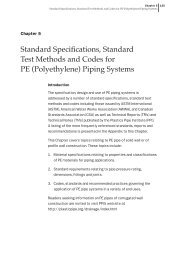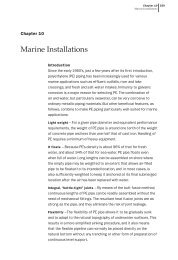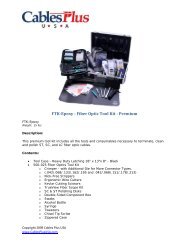Learning About Options in Fiber - Cables Plus USA
Learning About Options in Fiber - Cables Plus USA
Learning About Options in Fiber - Cables Plus USA
You also want an ePaper? Increase the reach of your titles
YUMPU automatically turns print PDFs into web optimized ePapers that Google loves.
SECTION 2—FIBER-OPTIC BASICS<br />
The center, or axial mode would be the slowest mode<br />
<strong>in</strong> the graded-<strong>in</strong>dex fiber Figure 2-5). In this circumstance,<br />
a mode would slow down when pass<strong>in</strong>g<br />
through the center of the fiber and accelerate when<br />
pass<strong>in</strong>g through the outer areas of the core. This is<br />
designed to allow the higher order modes to arrive<br />
at approximately the same time as an axial or lower<br />
order mode. This allows the multimode graded<strong>in</strong>dex<br />
fibers to transmit as far as 15-20 kilometers<br />
without great pulse spread<strong>in</strong>g. With<strong>in</strong> these classifications<br />
there are three types of fiber:<br />
• Multimode step-<strong>in</strong>dex.<br />
• Multimode graded-<strong>in</strong>dex.<br />
• S<strong>in</strong>gle-mode step-<strong>in</strong>dex.<br />
Figure 2-3—Graded Index <strong>Fiber</strong><br />
n 6<br />
n 5<br />
n 4<br />
n 3<br />
n 2<br />
n 1<br />
Figure 2-4—High-Order Mode<br />
Light rays pass<strong>in</strong>g through<br />
multiple layers of glass<br />
STEP INDEX<br />
Multimode Step-Index <strong>Fiber</strong><br />
• Bandwidth of 10 MHz/km<br />
• Loss of 5-20 dB/km.<br />
• Large cores of 200 to 1000 microns.<br />
• Cladd<strong>in</strong>g OD up to 1035 microns.<br />
• Is effective with low-cost LEDs<br />
• Limited transmission distances.<br />
• Transmits at 660-1060 wavelengths.<br />
Figure 2-5—Low-Order Mode<br />
S<strong>in</strong>gle-Mode Step Index <strong>Fiber</strong><br />
• High bandwidth applications (4 GHz).<br />
• Low losses, typically .3 dB to .5 dB/km.<br />
• Core area of 8 to 10 microns.<br />
• Cladd<strong>in</strong>g OD of 125 microns.<br />
• Transmits at 1300 nm and 1550 nm wavelengths.<br />
• Higher costs for connectors, splices, and test<br />
equipment, and transmitters/receivers.<br />
Plastic Step-Index <strong>Fiber</strong><br />
• Lower bandwidth 5 MHz over distances of<br />
200 feet.<br />
• Losses of 150-250 dB/km.<br />
• Core area from 1000-3000 microns.<br />
• Cladd<strong>in</strong>g up to 3000 microns.<br />
• Uses LEDs to transmit data very well.<br />
• Very easy to connectorize.<br />
• Inexpensive.<br />
• Operates best at 660 nm red wavelength.<br />
Plastic-Clad Silica Step-Index <strong>Fiber</strong><br />
• Bandwidth up to 25 MHz/km<br />
• Losses of 6-10 dB/km.<br />
• Glass core from 200-600 microns.<br />
• Plastic cladd<strong>in</strong>g OD to 1000 microns.<br />
• LEDs used to transmit data.<br />
Difficult to connectorize and unstable.<br />
• Very resistant to radiation.<br />
• Operates at 660-1060 wavelengths.<br />
GRADED INDEX<br />
Multimode Graded-Index <strong>Fiber</strong><br />
• Bandwidths up to 600 MHz/km.<br />
• Losses of 2 to 10 dB/km.<br />
• Cores of 50/62.5/85/100 microns.<br />
• Cladd<strong>in</strong>g OD of 125 and 140 microns.<br />
• Is effective with laser or LED sources.<br />
• Medium- to low-cost for components, test<br />
equipment, and transmitters and receivers.<br />
2-3


